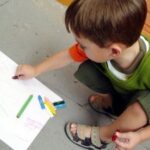Helping your child prepare to read is a fundamental goal of parents. There are specific areas that you can work on with your child in order to enhance his kindergarten reading skills. The following skills are evaluated for reading readiness in kindergarteners.
Sight Words: In kindergarten, your child will get a list of words to memorize. These words are called sight words because children learn to recognize them by sight. These are basic words that form sentence structures. If your child can read these words then he is better able to figure out the remainder of the sentence.
Sight words include articles, pronouns, verbs, colors, and numbers. Sometimes pure memorization is not enough. Your kindergartener may also have to sound out the words in order to learn them.
Recognizing Colors: Color recognition is important to kindergarten reading because recognizing colors helps the brain with word mapping. This skill starts when the child is still a toddler. The child learns to associate colors with the names of objects.
Colors are included in the kindergarten sight word lists. As the word mapping happens, your child will not only be able to identify the color but they will also learn to read the word.
Rhyming Words: Words that rhyme teaches kindergarteners the patterns of words. Mastering this skill may take time because many kids try to rhyme the first sound or letter of the word instead of the last syllable.
Using rhyming words helps to simplify words. If a child phonetically sounds out a word, the word can end up with more syllables than it should have. Rhyming gives the words rhythm without overemphasis on any one letter.
Recognizing Capital and Lower Case Letters: Your kindergartener will be evaluated on how well he recognizes the same letter in lower case or in capital form. He will be given a jumbled line that includes both cases along with different letters. This skill is important because your child will able to connect the fact that two letters are the same even though they look different.
You can help your child recognize lower case and capital letters by writing the different letters in different forms across a line on a page. Always work left to right through the line. This will help reinforce how he should read, from left to right.
Recognizing Letter Sounds: It is very important to attach the proper sound to the correct letter. The only way that your child will be able to learn new words is if he can sound them out.
To help your kindergartener learn the sounds, separate the vowels from the consonants. Vowels normally have two sounds associated with them which make them slightly harder to learn.
Arranging Letters in Sequence: Your kindergartener will not only be reading but also he will be spelling. Arranging the letters alphabetically solidifies the order of letters.
Start with jumbled up letters of the alphabet. Have your child place the “A” on the left, followed by the “B”. Again, always work from left to right. As soon as he knows all the letters of the alphabet, you can play this game with the sight words. This will connect the recognition of words to their spellings.
Blending Sounds into Words: This is the final step to help your child learn to read. Once he has learned his letters, their sounds, and reading words from left to right he is ready to sound out words that he is not familiar with yet.
You can help your child when you practice the sight words. Your kindergartener may struggle memorizing some words. Practice sounding out each letter. Try to help him blend his sounds instead of making them independent. For example, the word “was” sounded out sounds like wah-a-s. This gives the word two syllables. Help your child drop the “ah” sound at the end of pronouncing the “w” sound.
You can help your kindergartener learn to read by pointing out and naming colors. You can play a rhyming word game in the car. The opportunities to give your child the groundwork for reading are endless.
Sources:
Personal experience
http://wondertime.go.com/learning/article/recognizing-color.html
http://specialed.about.com/od/wordwalls/a/families.htm


